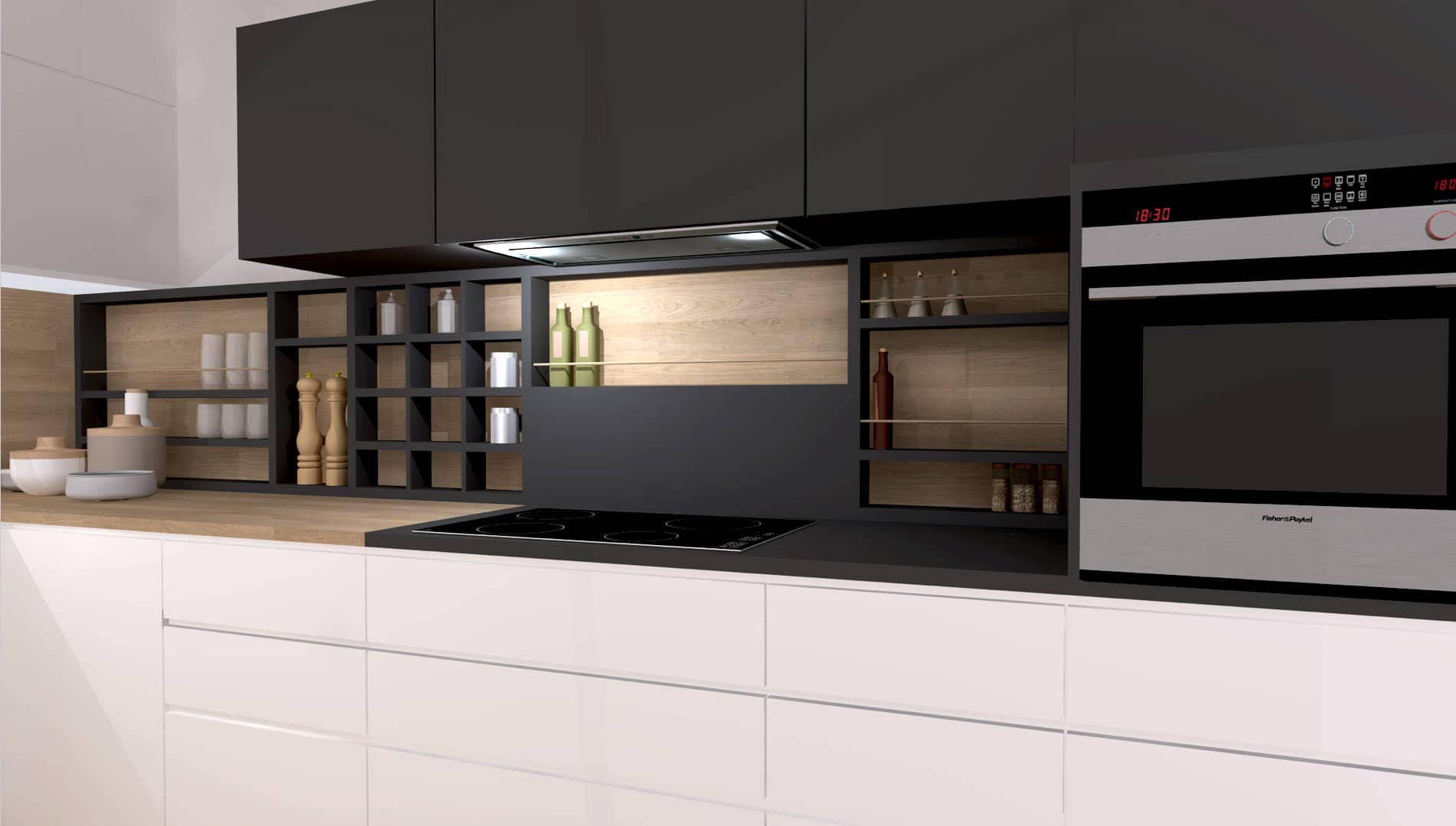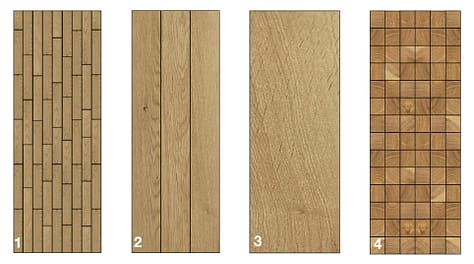Solid Wood Worktops

Kitchen Worktop Guide Part III: Solid Wood
Solid wood is a beautiful product of nature we have been using for thousands of years to build our habitats, tools, transport, furniture, etc. Its uniqueness and charm make it a timeless choice suitable for any style, traditional and modern, as it brings warmth and ages beautifully, deepening in colour and character. Being renewable it can be considered fairly environmentally friendly, but care should be taken that it is from a close to home sustainable source, approved by FSC (Forest Stewardship Council). Wood is classified in grades and sub-grades in terms of appearance and Janka method and scale to indicate its hardness.
How is it made
Solid wood kitchen worktops are usually composed of different lengths and widths of wood called staves. There are four main types of worktop construction:
1 – Smaller staves, 40-50mm wide and of various lengths, are joined in a staggered formation to create larger surface suitable for worktops. They are often called butchers’ block worktops because of smaller pieces of wood in its composition.
2 – Worktops are constructed of full length staves, 90mm to slightly above 200mm wide. In most cases prime or A grade timber is used for the construction, and appearance is more elegant and refined, along with the price.
3 – Full width stave or single solid wood plank worktops are harder to come by and require bottom reinforcement to prevent warping. There are engineered varieties where wood veneer is placed on top of substrate, usually made of smaller staves, which provide stability.
4 – End grain cuts are most often used for construction of butcher blocks or chopping boards, but there are beautiful examples of entire worktops made in this style.
If your kitchen is L or U shaped the worktop surfaces usually meet at the right angle which some of us find particularly bothersome. Solution is to cut both planks at a 45-degree angle, resulting in a more elegant appearance, albeit at the higher cost.
Recommended Care for Solid Wood Worktop
Wood is softer than other materials and can be easily damaged if not treated and taken care of properly. Oils and hard waxes help greatly with durability and they must be of food grade. Many people will find that slight damage like scratches, dents and burn marks are relatively easy to fix. Chopping boards and trivets are necessary to maintain an unblemished appearance. Following advice applies to all solid wood worktops:
– splashes should be wiped off promptly to prevent staining, using dry cloth
– if left unattended, a great deal of patina will develop from coffee/tea cups, wine bottles, food cans, etc.
– temperature sensitive so hot pots should not be placed directly on the surface; the same applies to dirty and wet pots
– do not cut on the surface directly, use chopping boards
– most metal can stain wood, including tins
– cleaning is done best with a damp lint-free cloth and warm lightly soapy water
– avoid multi-purpose cleaning products as they can contain ingredients damaging to wood
– avoid using hard-surfaced cleaning pads as you might remove protection
– scratches, chips, cracks, holes and marks can be sanded and, if needed, repaired with wood filler and refinished
– gets darker over time
– oil or wax every few months
The sheer volume of wood species worktops are made from can be either thrilling or overwhelming, but most popular choices are usually hardwoods like oak, walnut and iroko (African teak), so we’ll have a look at the main trio.
Solid Oak
There is no consensus on oak worktops. For some people it is the perfect choice in terms of aesthetics, durability and care, while for others a burden requiring never-ending attention. If after a pristine look for your kitchen, you would have to take great care of it – it is recommended to oil the entire surface prior to installation and then every day during the first week. Afterwards protection should be applied regularly every few months. Many people find pleasure in this process and treat their oak kitchen worktop as an animate object. In terms of colours, it comes in all shades and can be constructed from shorter standard staves or, in some premium versions, full length and width staves or solid planks.
Walnut
Most suppliers stock two types of walnut kitchen worktops: a lighter variety European walnut and its darker North American cousin known as American Black (Juglans nigra). The beauty of walnut can astound due to its dense grain structure and varied colouring. When used for furniture and worktops it often appears quite luxurious and will definitely make a statement.
Iroko
Also known as African teak for their similarities, iroko is one of the largest African trees. It is a highly durable timber, thanks to its high oil content. It is more resistant to fluctuations in temperature and moisture and can withstand busy environments. It comes in pale to mid yellows but darkens with application of oil or wax. The deep shades of gold and bronze and irregular grains make it appear lively and warm. Of all solid wood worktops, iroko seems to be the hardiest and most recommended for busy households not overly precious with their kitchen. Being sourced from central Africa it cannot get FSC certification, however some suppliers have strict policies making sure it is sustainably sourced.
Other solid wood used for worktops are wenge, ash, cherry, maple, beech, birch, sapele, zebrano and bamboo, latter being a grass.
Reclaimed Wood
If looking for a truly unique kitchen countertop, instead of reaching for endangered exotic species, reclaimed wood could be the answer. There are no two that look the same and despite belief that they suit rustic and vintage style of decor only, they can provide beautiful and lively contrast to modern and sleek surroundings. Reclaimed wood countertops, contrary to belief, do not come cheap due to work involved in sourcing and restoration, and its limited supply. Reclaimed wood comes from a variety of origins: barns, industrial warehouses, scaffolding, old properties, churches, schools, labs, etc. and has to be inspected for potential contamination from previous wood treatments and infestation. For this reason, and to avoid false provenance claims, always use a reputable supplier.
Huge advantage of reclaimed timber is its exceptional durability: heavy use, exposure, hundreds of expansions and contractions in its lifetime. This process makes it more stable and hardier than most of its fresh counterparts. Another plus is that you can come across wood species that are no longer in widespread use because of their scarcity. Reclaimed wood is definitely a sustainable and eco friendly choice that can contribute environmental points to your project.
To help with your choice, you can visit our Pinterest board dedicated to solid wood kitchen worktops.
